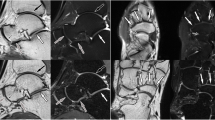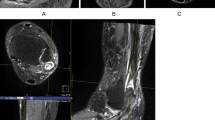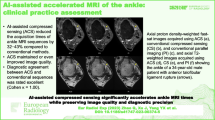Abstract
Objectives
To test the hypothesis that MRI of the ankle with a 10-min 3D CAIPIRINHA SPACE TSE protocol is at least equivalent for the detection of painful conditions when compared to a 20-min 2D TSE standard of reference protocol.
Methods
Following institutional review board approval and informed consent, 70 symptomatic subjects underwent 3T MRI of the ankle. Six axial, sagittal and coronal intermediate-weighted (IW) and fat-saturated T2-weighted (T2FS) 2D TSE (total acquisition time, 20 min), and two sagittal isotropic IW and T2FS 3D CAIPIRINHA TSE (10 min) pulse sequence prototypes were obtained. Following randomization and anonymization, two musculoskeletal radiologists evaluated the 2D and 3D datasets independently. Descriptive statistics, inter-reader reliability, inter-method concordance, diagnostic definitiveness tests were applied. P-values < 0.05 were considered significant.
Results
Raters diagnosed 116 cartilage defects with 2D and 109 with 3D MRI, 35 ligament tears with 2D and 65 with 3D MRI, 18 tendon tears with 2D and 20 with 3D MRI, and 137 osseous abnormalities with 2D and 149 with 3D MRI. The inter-reader agreement was high for 2D (Kendall W, 0.925) and 3D MRI (W, 0.936) (p < 0.05), as was the inter-method concordance (W, 0.919). The diagnostic definitiveness of readers was higher for 3D MRI than 2D MRI in 10-27% of the time, while the reverse was true in 7-11% of the time (p < 0.01).
Conclusions
The performance of 10-min 3D CAIPIRINHA SPACE MRI for the detection of painful ankle conditions is similar to that of a 20-min 2D TSE MRI reference standard.
Key Points
• CAIPIRINHA Acceleration facilitates isotropic 3D MRI of the Ankle in 10 min.
• 10-min 3D CAIPIRINHA MRI and 20-min 2D TSE MRI have similar performance.
• 3D CAIPIRINHA SPACE MRI afforded higher diagnostic definitiveness of readers.






Similar content being viewed by others
Abbreviations
- 2D :
-
Two-dimensional
- 3D:
-
Three-dimensional
- CAIPIRINHA :
-
Controlled aliasing in parallel imaging results in higher acceleration
- IW :
-
Intermediate-weighted
- MRI :
-
Magnetic resonance imaging
- SPACE :
-
Sampling perfection with application optimized contrast using different flip angle Evolution
- T2FS :
-
Fat-suppressed T2-weighted
- TSE :
-
Turbo spin echo
References
Rosenberg ZS, Beltran J, Bencardino JT (2000) From the RSNA Refresher Courses. Radiological Society of North America. MR imaging of the ankle and foot. Radiographics. 20(Spec No):S153-179
Kreitner KF, Ferber A, Grebe P, Runkel M, Berger S, Thelen M (1999) Injuries of the lateral collateral ligaments of the ankle: assessment with MR imaging. Eur Radiol 9(3):519–524
Cheung Y, Rosenberg ZS (2001) MR imaging of ligamentous abnormalities of the ankle and foot. Magn Reson Imaging Clin N Am 9(3):507–531 x
Leffler S, Disler DG (2002) MR imaging of tendon, ligament, and osseous abnormalities of the ankle and hindfoot. Radiol Clin North Am 40(5):1147–1170
Mengiardi B, Pfirrmann CW, Vienne P, Hodler J, Zanetti M (2007) Medial collateral ligament complex of the ankle: MR appearance in asymptomatic subjects. Radiology 242(3):817–824
Mengiardi B, Zanetti M, Schöttle PB et al (2005) Spring ligament complex: MR imaging-anatomic correlation and findings in asymptomatic subjects. Radiology 237(1):242–249
Duc SR, Mengiardi B, Pfirrmann CW, Hodler J, Zanetti M (2007) Improved visualization of collateral ligaments of the ankle: multiplanar reconstructions based on standard 2D turbo spin-echo MR images. Eur Radiol 17(5):1162–1171
Notohamiprodjo M, Kuschel B, Horng A et al (2012) 3D-MRI of the ankle with optimized 3D-SPACE. Invest Radiol 47(4):231–239
Kim M, Choi YS, Jeong MS et al (2017) Comprehensive assessment of ankle syndesmosis injury using 3D isotropic turbo spin-echo sequences: diagnostic performance compared with that of conventional and oblique 3-T MRI. AJR Am J Roentgenol 208(4):827–833
Hermans JJ, Ginai AZ, Wentink N, Hop WC, Beumer A (2011) The additional value of an oblique image plane for MRI of the anterior and posterior distal tibiofibular syndesmosis. Skeletal Radiol 40(1):75–83
Notohamiprodjo M, Horng A, Pietschmann MF et al (2009) MRI of the knee at 3T: first clinical results with an isotropic PDfs-weighted 3D-TSE-sequence. Invest Radiol 44(9):585–597
Jung JY, Yoon YC, Kwon JW, Ahn JH, Choe BK (2009) Diagnosis of internal derangement of the knee at 3.0-T MR imaging: 3D isotropic intermediate-weighted versus 2D sequences. Radiology 253(3):780–787
Stevens KJ, Busse RF, Han E et al (2008) Ankle: isotropic MR imaging with 3D-FSE-cube: initial experience in healthy volunteers. Radiology 249(3):1026–1033
Park HJ, Lee SY, Choi YJ et al(2017) 3D isotropic T2-weighted fast spin echo (VISTA) versus 2D T2-weighted fast spin echo in evaluation of the calcaneofibular ligament in the oblique coronal plane. Clin Radiol 72(2):176 e1- e7
Fritz J, Fritz B, Thawait GG, Meyer H, Gilson WD, Raithel E (2016) Three-dimensional CAIPIRINHA SPACE TSE for 5-minute high-resolution MRI of the knee. Invest Radiol 51(10):609–617
Kalia V, Fritz B, Johnson R, Gilson WD, Raithel E, Fritz J (2017) CAIPIRINHA accelerated SPACE enables 10-min isotropic 3D TSE MRI of the ankle for optimized visualization of curved and oblique ligaments and tendons. Eur Radiol 27(9):3652–3661
Mosher TJ, Kransdorf MJ, Adler R et al (2015) ACR Appropriateness Criteria acute trauma to the ankle. J Am Coll Radiol 12(3):221–227
DeSmet AA, Dalinka MK, Alazraki N et al (2000) Chronic ankle pain. American College of Radiology. ACR Appropriateness Criteria. Radiology 215(Suppl):321–332
Bidgood WD Jr, Horii SC (1992) Introduction to the ACR-NEMA DICOM standard. Radiographics 12(2):345–355
Obuchowski NA, Subhas N, Schoenhagen P (2014) Testing for interchangeability of imaging tests. Acad Radiol. 21(11):1483–1489
Noyes FR, Stabler CL (1989) A system for grading articular cartilage lesions at arthroscopy. Am J Sports Med 17(4):505–513
Kijowski R, Blankenbaker DG, Davis KW, Shinki K, Kaplan LD, De Smet AA (2009) Comparison of 1.5- and 3.0-T MR imaging for evaluating the articular cartilage of the knee joint. Radiology 250(3):839–848
Landis JR, Koch GG (1977) The measurement of observer agreement for categorical data. Biometrics 33(1):159–174
Breuer FA, Blaimer M, Mueller MF et al (2006) Controlled aliasing in volumetric parallel imaging (2D CAIPIRINHA). Magn Reson Med 55(3):549–556
Yutzy SR, Seiberlich N, Duerk JL, Griswold MA (2011) Improvements in multislice parallel imaging using radial CAIPIRINHA. Magn Reson Med 65(6):1630–1637
Yi J, Cha JG, Lee YK, Lee BR, Jeon CH (2016) MRI of the anterior talofibular ligament, talar cartilage and os subfibulare: Comparison of isotropic resolution 3D and conventional 2D T2-weighted fast spin-echo sequences at 3.0 T. Skeletal Radiol 45(7):899–908
Park HJ, Lee SY, Park NH et al (2016) Three-dimensional isotropic T2-weighted fast spin-echo (VISTA) ankle MRI versus two-dimensional fast spin-echo T2-weighted sequences for the evaluation of anterior talofibular ligament injury. Clin Radiol 71(4):349–355
Schmid MR, Pfirrmann CW, Hodler J, Vienne P, Zanetti M (2003) Cartilage lesions in the ankle joint: comparison of MR arthrography and CT arthrography. Skeletal Radiol 32(5):259–265
Funding
This study has received funding by Siemens AG.
Author information
Authors and Affiliations
Corresponding author
Ethics declarations
Guarantor
The scientific guarantor of this publication is Jan Fritz.
Conflict of interest
The authors of this paper declare relationships with the following companies: Siemens AG.
Statistics and biometry
One of the authors has significant statistical expertise.
Informed consent
Written informed consent was obtained from all subjects in this study.
Ethical approval
Institutional Review Board approval was obtained.
Methodology
• prospective
• experimental
• performed at one institution
Rights and permissions
About this article
Cite this article
Fritz, B., Bensler, S., Thawait, G.K. et al. CAIPIRINHA-accelerated 10-min 3D TSE MRI of the ankle for the diagnosis of painful ankle conditions: Performance evaluation in 70 patients. Eur Radiol 29, 609–619 (2019). https://doi.org/10.1007/s00330-018-5591-z
Received:
Revised:
Accepted:
Published:
Issue Date:
DOI: https://doi.org/10.1007/s00330-018-5591-z




